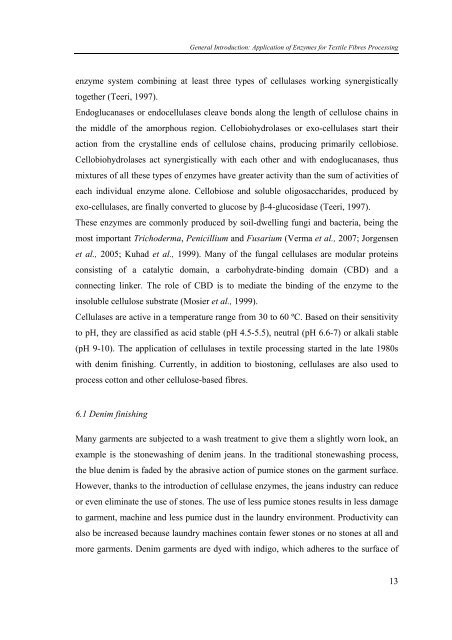Surface Modification of Cellulose Acetate with Cutinase and ...
Surface Modification of Cellulose Acetate with Cutinase and ...
Surface Modification of Cellulose Acetate with Cutinase and ...
You also want an ePaper? Increase the reach of your titles
YUMPU automatically turns print PDFs into web optimized ePapers that Google loves.
General Introduction: Application <strong>of</strong> Enzymes for Textile Fibres Processing<br />
enzyme system combining at least three types <strong>of</strong> cellulases working synergistically<br />
together (Teeri, 1997).<br />
Endoglucanases or endocellulases cleave bonds along the length <strong>of</strong> cellulose chains in<br />
the middle <strong>of</strong> the amorphous region. Cellobiohydrolases or exo-cellulases start their<br />
action from the crystalline ends <strong>of</strong> cellulose chains, producing primarily cellobiose.<br />
Cellobiohydrolases act synergistically <strong>with</strong> each other <strong>and</strong> <strong>with</strong> endoglucanases, thus<br />
mixtures <strong>of</strong> all these types <strong>of</strong> enzymes have greater activity than the sum <strong>of</strong> activities <strong>of</strong><br />
each individual enzyme alone. Cellobiose <strong>and</strong> soluble oligosaccharides, produced by<br />
exo-cellulases, are finally converted to glucose by β-4-glucosidase (Teeri, 1997).<br />
These enzymes are commonly produced by soil-dwelling fungi <strong>and</strong> bacteria, being the<br />
most important Trichoderma, Penicillium <strong>and</strong> Fusarium (Verma et al., 2007; Jorgensen<br />
et al., 2005; Kuhad et al., 1999). Many <strong>of</strong> the fungal cellulases are modular proteins<br />
consisting <strong>of</strong> a catalytic domain, a carbohydrate-binding domain (CBD) <strong>and</strong> a<br />
connecting linker. The role <strong>of</strong> CBD is to mediate the binding <strong>of</strong> the enzyme to the<br />
insoluble cellulose substrate (Mosier et al., 1999).<br />
Cellulases are active in a temperature range from 30 to 60 ºC. Based on their sensitivity<br />
to pH, they are classified as acid stable (pH 4.5-5.5), neutral (pH 6.6-7) or alkali stable<br />
(pH 9-10). The application <strong>of</strong> cellulases in textile processing started in the late 1980s<br />
<strong>with</strong> denim finishing. Currently, in addition to biostoning, cellulases are also used to<br />
process cotton <strong>and</strong> other cellulose-based fibres.<br />
6.1 Denim finishing<br />
Many garments are subjected to a wash treatment to give them a slightly worn look, an<br />
example is the stonewashing <strong>of</strong> denim jeans. In the traditional stonewashing process,<br />
the blue denim is faded by the abrasive action <strong>of</strong> pumice stones on the garment surface.<br />
However, thanks to the introduction <strong>of</strong> cellulase enzymes, the jeans industry can reduce<br />
or even eliminate the use <strong>of</strong> stones. The use <strong>of</strong> less pumice stones results in less damage<br />
to garment, machine <strong>and</strong> less pumice dust in the laundry environment. Productivity can<br />
also be increased because laundry machines contain fewer stones or no stones at all <strong>and</strong><br />
more garments. Denim garments are dyed <strong>with</strong> indigo, which adheres to the surface <strong>of</strong><br />
13

















